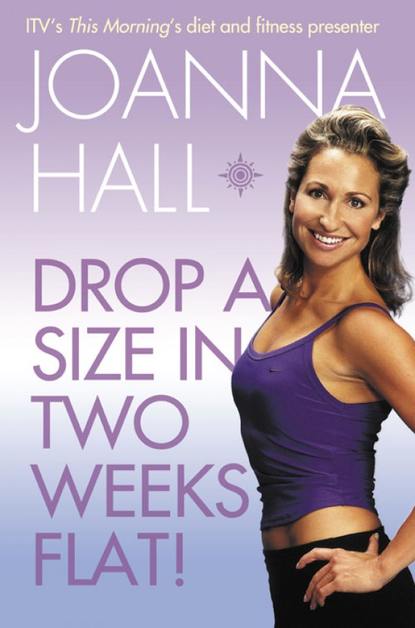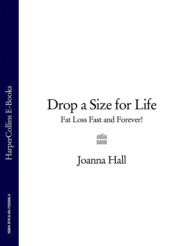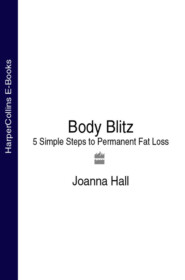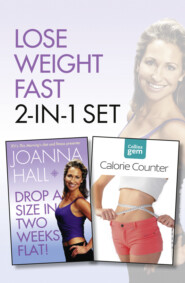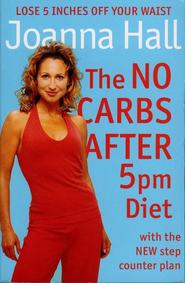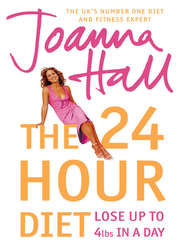По всем вопросам обращайтесь на: info@litportal.ru
(©) 2003-2024.
✖
Drop a Size in Two Weeks Flat!
Автор
Год написания книги
2019
Настройки чтения
Размер шрифта
Высота строк
Поля
THE DIET PLAN
The eating plan is a carefully constructed low-calorie diet based on low glycemic index carbohydrates, to prevent the energy highs and lows that can lead to bingeing; dietary fiber, to help you feel satisfied; essential fatty acids for a healthy heart and efficient metabolic functioning; plenty of water-packed fruit, salad and vegetables to insure sufficient vitamin and mineral intake; and protein, essential for tissue repair, maintenance and growth.
The plan incorporates my Starch Curfew, a strategy that restricts carbohydrate intake after 5 p.m. to help you consume nutrients at the right time of day and maximize weight loss. It also has a high content of liquid-based foods, such as soups, stews and juices, because research has shown that these leave you feeling more satiated than a drier diet, even those that involve a high water intake. In one study, women who sipped a broth before they ate lunch consumed 100 fewer calories than those who did not – and felt less hungry later in the day.
The eating plan is easy to follow and clearly explained, with options for cooking at home as well as eating on the run, and while it is a low-calorie diet – providing approximately 1300 cals a day (1600 for men) – you can be assured that it’s nutrient rich.
THE EXERCISE PLAN
Follow the 14-day eating plan and you’ll soon be looking and feeling better. But for total health, vitality and successful weight loss, one crucial part of the jigsaw is still missing – exercise. Physical activity raises resting metabolism, increases calorie-hungry lean body mass, and improves your body’s ability to burn fat as a fuel.
For convenience and simplicity, the aerobic exercise featured in the 14-day plan is simply walking. It’s not only good for your figure but your health, too – recent research has shown that regular walking for as little as an hour a week is associated with lower incidence of heart disease in women. In the plan you will find that 10- to 30-minute bouts of walking are suggested at specific times during the day, but if you really can’t fit them in, then stick to one daily walk. Some research shows that doing repeated bouts of exercise actually burns more calories than doing one prolonged session, due to the effect of exercise on metabolism, but the overall rule is to be as active as you can, as often as you can. There are daily step targets to aim for, to provide a guide to how much walking you need to do during the 14 days to get results. You’ll need a pedometer – these are available for $10–$35 from good athletic equipment stores.
The daily walking is complemented by a targeted 10-minute home routine of abdominal and core stability exercises to tone up your abdominals and improve posture, all helping you to streamline your silhouette.
Alongside the walking and core exercises, try to find time to fit more “lifestyle” activity into each of the 14 days. These are activities that can be easily incorporated into your day and don’t require you to get into your gym clothes and sneakers. Here are some everyday tasks that will help increase calorie expenditure.
Burn 100 calories without exercising by …
Shopping for half an hour
Gardening for 20 minutes
Dancing for 20 minutes
Making the bed 5 days a week
Walking up stairs for 10 minutes
Cooking for 40 minutes
Cleaning for 25 minutes
ARE YOU READY TO DROP A DRESS SIZE?
Before you start, get a piece of paper and write down your answers to the following questions:
Why do you want to drop a size? Try to think of at least three reasons.
Do you have a particular deadline or event in mind? If so, write it down.
Why do you think you have failed with previous weight loss attempts?
What will be different this time?
Are you willing to add daily activity to your life? Think of three ways you could add even just a little more physical activity to your daily routine.
How do you think being slimmer, fitter, and healthier will affect your life?
Hopefully, the answers to the above questions will have helped focus your mind on the task in hand a little. Research shows that people who have an “intrinsic” or internal motivation to achieve something are more likely to persevere than those who are motivated by “extrinsic” rewards. For example, believing that you’ll feel better about yourself if you drop a dress size is likely to help you stick with the plan more than having to lose weight for your best friend’s wedding. It’s important to be in the right frame of mind – positive, motivated, and confident – before you start and while on the Get a Grip plan. That’s why you’ll find a positive mantra and top tip for each day of your 14-day plan. It’s also equally important to be practically and physically prepared. Make sure you have 14 days in which to commit yourself fully to this program – that means there should be no champagne-fueled parties or candle-lit dinners in your diary. Read through the next few pages and before you start make sure you have everything you need to make the plan a success.
IS MOTHER NATURE ON YOUR SIDE?
No matter how ready and willing you are to change your body, there are natural limitations that may influence your success. I call it the “Three M Theory” – your mother, your metabolism, and your motivation.
YOUR MOTHER
The way you were brought up can have a strong influence on your relationship with food later in life. Research from Pennsylvania State University showed that women who are faddy about foods tend to subconsciously pass on their finicky ways to their daughters. If your mother actively encouraged you not to eat certain foods or not to overeat, warning that it would make you fat, you probably label foods as “good” and “bad” without even realizing it. If you ate a lot of sweet and sugary things as you were growing up, and your diet didn’t include a variety of tastes, it is likely that you now crave calorie-dense sweet foods rather than savory ones. Maybe your mother used to say “finish everything on your plate” and you still do. These attitudes have taken a long time to build into habits, and they will take a long time to diminish. This book will help you reevaluate your relationship with food, showing you how to draw up a sensible eating plan that will help you realize your weight and body fat goals, as well as providing a positive health message for your children.
YOUR METABOLISM
Research shows that from your mid-twenties onwards, metabolism begins to decline year on year. It’s a sad fact that if you continue to consume the same number of calories without stepping up energy expenditure, gradual weight gain will result. In addition, there are specific times in life, for example during puberty, when fat cells are prone to get bigger and multiply. If we eat excessively during these times, it is likely that the body fat laid down in the fat cells will pose more of a problem to shift than the weight we gain at other times of our lives. This helps to explain why some friends appear to drop weight effortlessly while our own attempts require a lot more persistence. We are all designed to have fat cells, and they all have an ability to increase and decrease in size as we gain and lose weight. Appreciating this will allow you to approach this plan with a realistic picture of what you can achieve long term.
YOUR MOTIVATION
Consider this: what we weigh in seven years’ time will not be determined by what we do in the next seven hours, seven days or seven weeks but by what we do consistently for the next seven years. So if your initial motivation to take those first steps is to get into a little black dress in 14 days’ time – great! But once you’ve achieved that, use sections two and three to build on your success and make it last. Whatever your initial motivation to start the plan, try to find a way to translate it into a strategy that you can incorporate and build on to achieve your long-term weight and body fat goals. Establishing a strategy and action plan will be crucial, and the results that you’ll see in 14 days will be the driving force to help you do so.
GET SET
This section is all about the practical stuff – what you need to buy, or have handy, how to take your current measurements (to help you gauge your results), and clear instructions on how to use the plan.
What you’ll need:
To take your current measurements you’ll need a tape measure and a scale. If you don’t have a scale, it’s relatively easy to find one in a public place – try your local pool or drugstore.
A pedometer to monitor the number of steps you take each day during the 14-day plan (you may wish to continue using it after the 14 days, too). These are available from most sports stores or sports product mail-order companies.
A pair of good, supportive sneakers or walking shoes to wear on your daily ambles.
For the abdominal and core stability exercises, you’ll need some loose and comfortable clothing that doesn’t restrict your movement. You won’t work up a sweat, so don’t worry about changing into workout clothes unless you want to.
One last thing you may consider purchasing is a juicer. These can be bought fairly cheaply from most department and electrical stores and give you access to a wider (and fresher) range of juices than relying on store-bought versions.
KITCHEN CABINET ESSENTIALS
This list serves as a general shopping list of non-perishable items that are used during the 14-day plan. There may be some other non-perishable items required for specific recipes, but the list below should cover you for most eventualities.
Oils, sauces and condiments
Herbs and spices
Dried fruit and nuts
Cereals and cereal products
Beverages
Cans





